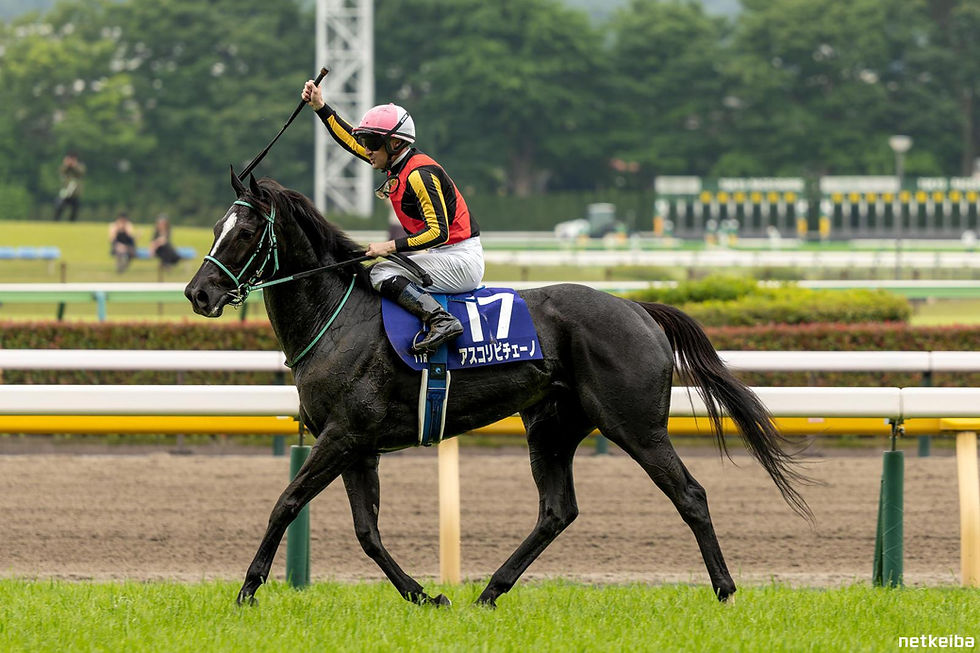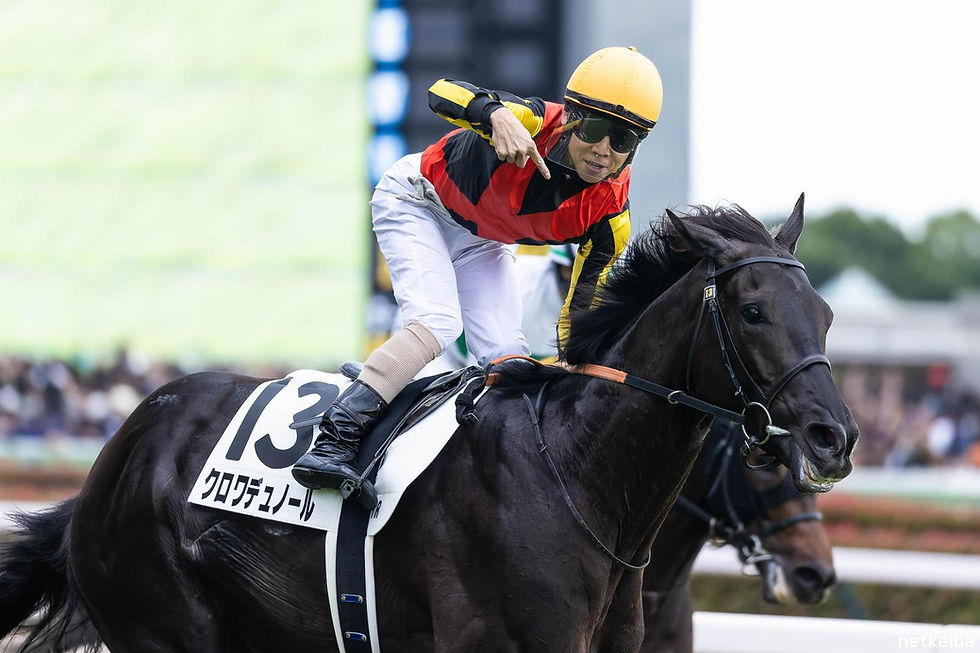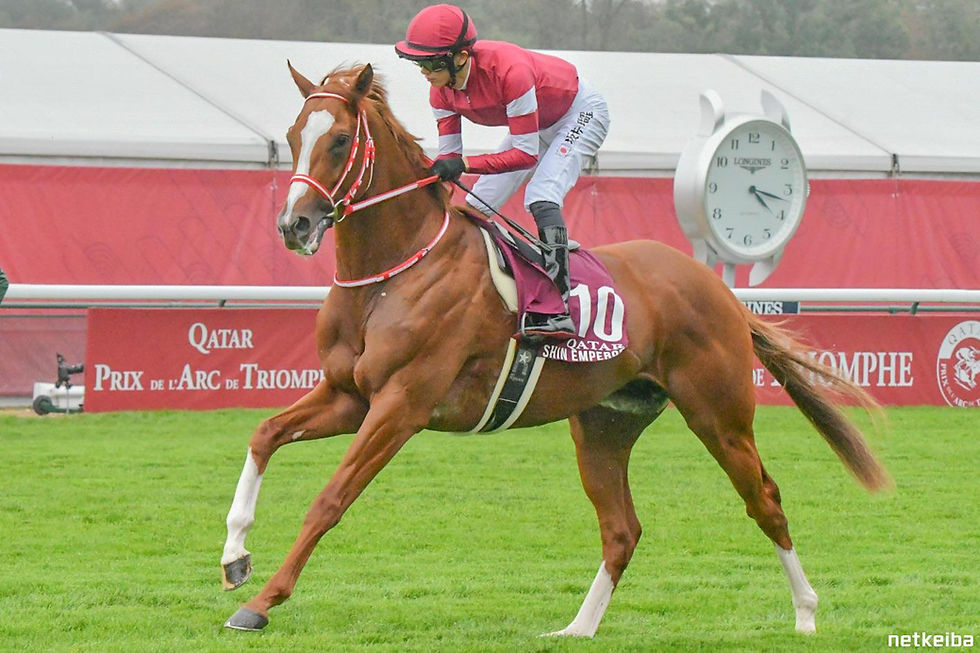Ascoli Piceno to Deauville: Japan’s mile ace targets the Prix Jacques le Marois
- Archie Brookes

- Aug 13
- 9 min read
Updated: Aug 21
Prix Jacque le Marois (G1), 1600m, 3yo+ - Deauville, Sunday 17 August 2025

Scene setter
On Sunday at Deauville, the Group 1 Prix Jacques le Marois (straight 1600m; €1m) will act as the mid-season championship for turf milers. Ascoli Piceno ships in as Japan’s leading miler: Champion 2-Year-Old Filly in 2023 after breaking the Hanshin Juvenile Fillies record (1:32.6), and a stakes-record winner of the Victoria Mile this May. The question is straightforward for a straight track: can her late speed translate, unfiltered by turns, against Europe’s best under weight-for-age?
The Deauville straight is a good laboratory. It strips away the noise you get around a bend and magnifies two things that decide elite miles: how efficiently a horse travels through the first 1000m, and how violently it can change gear from the 600m. Fields often fan across the course. Groups can form on different strips of ground. The horse that holds balance while producing top speed for the last 200m usually wins. That is exactly the test Ascoli Piceno seems built for.
Why the Marois matters
The Marois routinely determines the division’s pecking order and points directly toward autumn targets like the Breeders’ Cup Mile. It is also the race where international form lines collide on level terms - no bends, minimal tactics tax, maximal emphasis on sectional efficiency and acceleration. Japan has not won it since Taiki Shuttle (1998), which gives this attempt historical weight as well as sporting intrigue.
Look at the honour roll and you see why it matters: Miesque, Dubai Millennium, Dubawi, Kingman. Many Marois winners were not just the best miler on the day, but the best miler of their year. The winner often earns a stallion or broodmare upgrade, lines up a Breeders’ Cup campaign, and settles the Sussex vs Jacques le Marois debate that defines Europe’s summer mile narrative. For Japan, a win would echo Taiki Shuttle and reinforce the country’s modern model of exporting speed, temperament, and training systems that travel.
Race-by-race: the campaign to Deauville
24 Jun 2023 - Tokyo, 2yo Newcomer (1400m) Debut and statement. Sat midfield, changed leads cleanly, and powered through the final 300m to win with authority - stopping the clock in quick time and setting a new mark for the race. The raw material - balance, cadence, and straight-line efficiency - was obvious. She looked tractable and professional, not revved up.
27 Aug 2023 - Niigata Nisai Stakes (G3, 1600m) First step into graded company. From mid-pack she tracked the lane, quickened past the leader inside the last furlong, and won with something in hand. The mile looked natural. The efficiency curve from 800m to the line tightened again, and she posted a closing split that marked her out as a legitimate Group horse without being fully extended.
10 Dec 2023 - Hanshin Juvenile Fillies (G1, 1600m) Japan’s 2yo filly championship and a genuine stopwatch test. She delivered 1:32.6, a race record, to edge Stellenbosch by a neck and lock up the Champion 2-Year-Old Filly title. Baseline elite speed established. The figure hinted that she would be competitive in open-age company as a 3yo if she trained on.
07 Apr 2024 - Oka Sho / Japanese 1,000 Guineas (G1, 1600m) Classic mile, high pressure. Camped where she needed to be, launched, and was beaten only 0.1s by old rival Stellenbosch. The run showed she had indeed trained on. She absorbed a strong mid-race increase in tempo and still produced a decisive last 200m.
05 May 2024 - NHK Mile Cup (G1, 1600m) First crack at colts. Traveled like the best, traded late blows, and finished second to Jantar Mantar (later winner of the Yasuda Kinen), beaten 0.4s. Collateral form: strong. She handled the long Tokyo straight and did not shirk under pressure when struck by a rival’s momentum at the 200m.
08 Sep 2024 - Keisei Hai Autumn Handicap (G3, 1600m, Nakayama) Against older opposition under 55.5kg, she controlled her effort and stopped the clock in 1:30.8 (fast time). First 3yo filly in 39 years to land the race. The shape of the performance was instructive: she held a high cruising speed through the bend and still found length late, suggesting stamina at the mile is not a ceiling.
02 Nov 2024 - The Golden Eagle (1500m, Rosehill, AUS) The outlier. Favoured but 12th of 20 after being squeezed at the start. The three-week overseas stay and unfamiliar rhythm did not help. Connections treated it as a learning trip rather than a form guide. Importantly, no physical issue emerged, and she ate up post-race, which matters when projecting the next international assignment.
22 Feb 2025 - 1351 Turf Sprint (G2, 1351m, Riyadh) The rebound abroad. Parked close to the speed, found a seam, and won by a head over Win Marvel. Proved she can travel, adapt, and still produce late speed off a handy spot. Saudi’s firm turf and different gate cadence posed no problem. That win reset confidence for another northern-hemisphere challenge.
18 May 2025 - Victoria Mile (G1, 1600m, Tokyo) Career peak to date. Drawn 17, last early, then uncorked a 33.3s final 600m to nail Queen’s Walk on the post in 1:32.1 (stakes record) on rain-affected ground. Secured a Breeders’ Cup berth and underlined the repeatability of her change-of-gear. The combination of wide draw, softish ground, and a long sustained run is not easy to execute, yet she did it with economy and intent.
Summary: setting aside the Sydney misfire, she has finished first or second in every other start. The curve points upward into Deauville. The mix of front-half control and back-end speed is what wins straight-mile championships.
Ascoli Piceno's superb win in the G1 Victoria Mile
Versatility, surface, and scenario
She has won from forward positions (Riyadh) and from well off the pace (Tokyo). That duality matters at Deauville, where the race can either crawl then explode from the 600m or string out from halfway. Her best figures have come on sound ground, but she has demonstrated an effective change-up with a hint of cut. The skill to hold form across ground types while preserving a high acceleration index is what travels internationally.
Two scenarios frame her chance. If the first half of the race is steady, she should be able to settle, track cover, and shift into top speed late without losing balance when the field fans. If they go an honest clip from the 1200m, her Riyadh profile says she can sit within two lengths of the lead, change leads smoothly, and still produce a decisive last 200m. The variable is clear air. She is most effective when she can build her run without breaking rhythm.
Pedigree: built for the mile
By Daiwa Major (Sunday Silence line), she carries proven miler speed and mental toughness. The dam Ascolti is by Danehill Dancer, bringing European speed and balance. The female family (9-b) descends from Listen and connects to Henrythenavigator and Magician - a cluster that reliably produces high-class milers and intermediate-trip performers.
Three quick pedigree notes that matter for Deauville: 1) Daiwa Major progeny often have repeatable action and can handle firm going at speed. 2) The Danehill Dancer influence tends to sharpen turn of foot over 1200m to 1600m. 3) The 9-b family has thrown multiple Group 1 winners who handle straight tracks and quick ground. Bred by Northern Farm, she is a textbook Japanese-European cross for this exact test: straight-track miling that rewards speed, balance, and repeatable action.
Preparation and logistics
Ownership sits with Sunday Racing; training with Yoichi Kuroiwa (Miho). Post-Australia, the yard has adopted a short-ship strategy: complete the conditioning block at home, travel late, and minimize unknowns. She left Japan on 5 August and settled at Chantilly on 6 August, reportedly maintaining appetite, hydration, and demeanour - key markers for horses that rely on a sharp turn of foot.
The training principle is simple: preserve the top-end speed you worked to build at home. Short stays abroad reduce the risk of losing edge in a new routine. Chantilly’s quarantine base allows light spins, familiarity with European stalls, and a controlled environment for recovery. The team’s messaging is consistent with the horse’s profile: keep her fresh, keep her happy, and let her engine do the work on the day.
Rider and race shape
Christophe Lemaire - France-born, Japan-based - knows both the filly and the Deauville straight. The likely brief: secure cover through the first kilometre, avoid traffic when the field fans at the 400m, and time the release so her maximum velocity arrives inside the last 250m. If the early tempo is steady, she is optimally set. If they roll from the gun, her Riyadh run style shows she can absorb a more honest pace and still finish.
On the straight mile, riders often face the decision to go with the far-side group, join the stands-side, or sit middle and wait to see which lane travels. Lemaire’s strength is patience without paralysis. He tends to hold a line, delay the switch-out until the 350m, and then commit. That habit should suit a filly whose best asset is a clean, linear acceleration rather than a stop-start burst.
Opposition: benchmarking the field
This looks an open renewal with a strong 3-year-old cohort receiving weight. How they win, and where they are vulnerable:
Rosallion (GB, 3c) - dual G1 winner with a deep late kick; Sussex Stakes second after an outsider stole first run. Wins if he gets a tow into the 300m and finds a seam. Vulnerable if buried with 250m to go or if the race collapses into a pure test of sustained pace from halfway.
Henri Matisse (IRE, 3c) - Poule d’Essai des Poulains winner; high cruising speed and tactical tractability. Wins if the tempo is even and he controls the mid-race. Vulnerable if forced to change rhythm twice.
Camille Pissarro (IRE, 3c) - Prix du Jockey Club winner dropping back in trip. Dangerous with the allowance if the pace is even and the straight turns into a staying mile. Vulnerable if the last 400m becomes a pure speed test.
Zarigana (FR, 3f) - Poule d’Essai des Pouliches heroine. Receives both age and sex allowances. Wins if she travels sweetly behind a controlled gallop and is produced late. Vulnerable if drawn away from the main group or if the ground rides quick and exposes her change-up.
Go To First (JPN, 5h) - fellow Japanese runner who could influence the pace picture. His best role for Ascoli Piceno may be to ensure an honest tempo and a consolidated group.
Early markets framed Ascoli Piceno at double-figure odds (≈12-14/1) - a respectful price in a race without a dominant favourite. Price aside, the distribution of likely finishing times suggests narrow margins among the top five on most scenarios, which increases the value of tactical clarity and clean trips.
Track variables to monitor
Deauville’s straight mile is generally fair but draw, wind, and group dynamics can tilt outcomes. Watch for:
Ground - faster ground enhances her late speed. A going change toward good-to-soft increases the risk that the race turns into a three-furlong slog rather than a two-furlong blast.
Draw and lane - middle to stands’ side often advantageous if the field splits. If a bias emerges on earlier races, expect riders to migrate to it by the Marois.
Pace - a steady first 1000m shifts the test to raw change-of-gear. A solid gallop raises the stamina component and can blunt one-run closers if they move too soon.
Wind - a headwind punishes early leaders and helps cover-seekers. A tailwind makes the final 400m even more about maximum velocity.
Field shape - Rosallion’s position and cover could compress or expand the winning window for closers. A lone leader on the faster strip can make the race.
Historical context and upside
A victory would end a 27-year gap since Taiki Shuttle and further validate the modern Japanese model: domestic conditioning, targeted international placement, and pedigrees built for exportable performance. It would also strengthen her candidacy for year-end honours and sharpen the path to a trans-continental autumn. Even a podium would constitute a high-value result given the age allowances and the depth of the 3-year-old crop.
From a broader lens, another Japanese success in a European Group 1 mile would continue the trend of global convergence in training methods and breeding. The Sunday Silence line has matured into a reliable source of top-of-the-ground speed. When matched to European female families, you get horses like Ascoli Piceno who can lift in any jurisdiction that rewards balance and acceleration.
Verdict
On form and sectionals, Ascoli Piceno is a legitimate win candidate in an open Marois. Her turn of foot is repeatable and projectable: a 33.3s final 600m to a stakes-record Victoria Mile from gate 17, the ability to sit handy and still quicken to win the 1351 Turf Sprint, and a sequence of mile runs that show she can relax behind an even tempo, change up decisively from the 600m, and sustain the effort through the last 200m on a straight, WFA track while conceding the 3yo allowance to several key rivals. With clear air inside the last furlong, she has the tools to win this - and at current quotes she is compulsory on tickets and a credible each-way play.
Risk factors are not trivial: group splits can strand a closer, and the 3-year-old allowance is a real edge. But the profile is robust. If she breaks cleanly, travels within range, and Lemaire finds the lane at 350m, she will finish very fast. That is a formula that wins the Jacques le Marois more often than it misses.
Enjoyed this piece?
If this spotlight helped, please consider giving it a share and follow me on X
for more Japanese racing coverage, sectionals, and betting angles. You can also check archiebrookesracing.net for the latest spotlights and race-day notes. Cheers for reading.



Comments